
Mobility service dogs are trained to assist individuals with a wide range of mobility issues, from paralysis to arthritis.
They can help with everyday tasks such as opening doors, picking up items, and even helping their owners out of bed.
Mobility service dogs are often trained to respond to specific commands to perform these tasks, such as "pick up" or "open it."
Their owners can rely on them to provide physical support and assistance in situations where they might struggle on their own.
Meet the Teams
These highly trained teams are typically composed of a single mobility service dog and a handler, often a person with a disability.
Their primary goal is to assist their handler with daily tasks and provide emotional support.
Mobility service dogs can be trained to perform a wide range of tasks, such as opening doors, picking up items, and providing balance support.
These tasks can be tailored to the specific needs of the handler.
For another approach, see: Are Esa Service Dogs
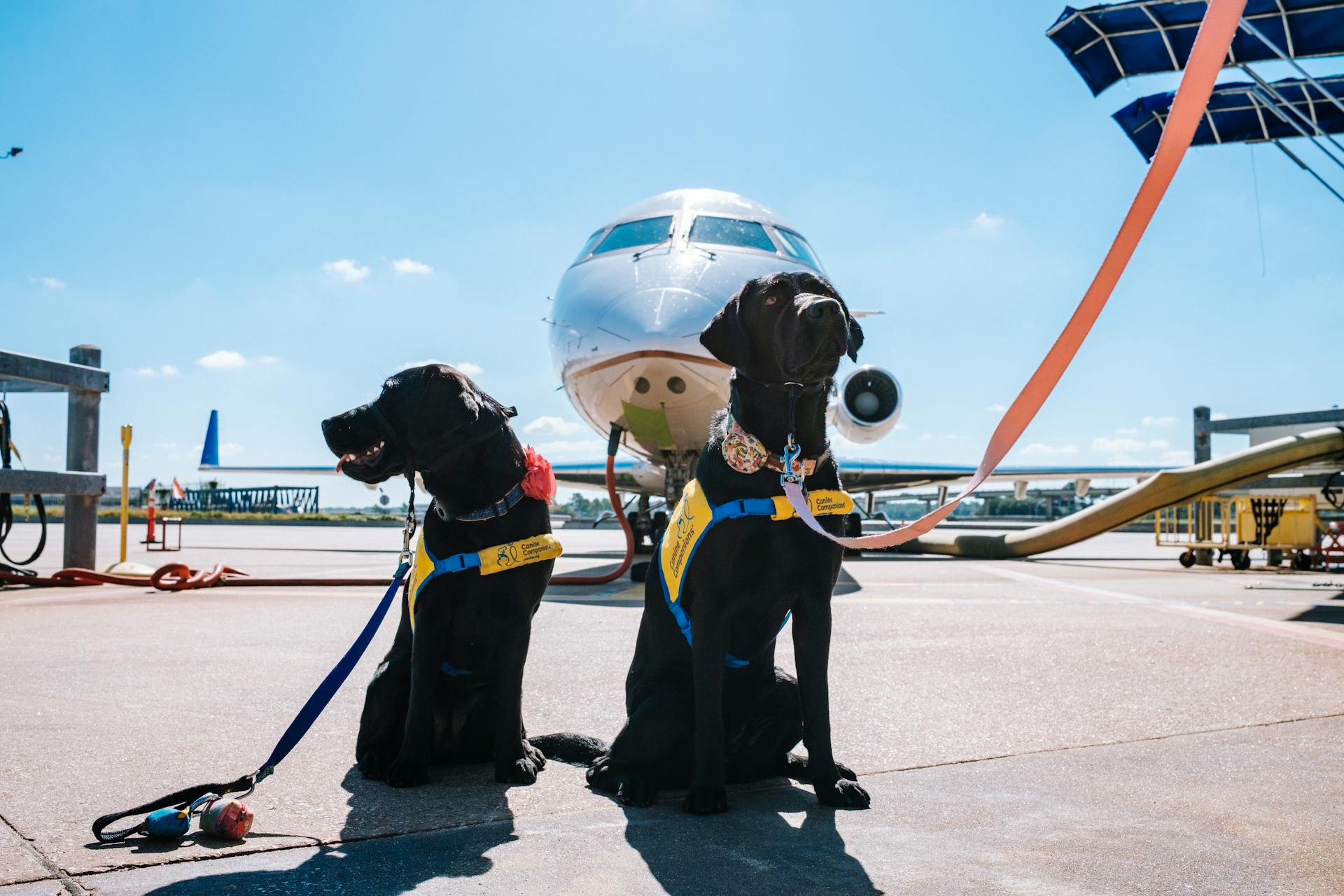
Some mobility service dogs are trained to assist people with conditions such as multiple sclerosis, arthritis, and paralysis.
Their training is rigorous and can take up to two years to complete.
These teams work together seamlessly, often becoming an extension of the handler's body.
Their bond is strong and deeply rooted in trust and respect.
Mobility service dogs are not just assistants, but also beloved companions.
Understanding Service Dogs
Service dogs are highly trained animals that assist individuals with disabilities, including mobility issues. They can be identified by their distinctive vests and harnesses.
A service dog's primary role is to provide physical support and assistance to their handler, helping them navigate through crowded spaces or avoid obstacles. They are trained to respond to specific commands and can even be trained to open doors or pick up items.
Service dogs can be trained to assist with a wide range of disabilities, including arthritis, multiple sclerosis, and spinal cord injuries.
You might like: Ada Law for Service Dogs
Denise and Axle

Denise and Axle are an inspiring example of the transformative power of service dogs. They were matched through Canine Partners for Life (CPL), an organization that trains dogs to meet specific individuals' needs.
Axle is a black Labrador Retriever who was trained by CPL to assist Denise with her physical and emotional health issues. He helps her walk short distances without a walker and retrieves items she drops.
Denise had been struggling with migraines and worried about going anywhere alone. Axle's training has enabled him to alert her before a migraine and lean against her if her blood pressure drops to prevent her from falling.
Axle has also restored Denise's independence, enabling her to volunteer in her community, teach Sunday School, and lead adult Bible studies. She's even been able to go off half of her daily medications.
CPL spends approximately $30,000 to train each dog, and families are asked to contribute financially when a match is made. Denise's family and church congregation held fundraisers to help her meet this goal.
Axle has flown with Denise to San Diego to visit family and has even gone into restaurants with her. His training has opened up a new world for Denise, enabling her to live a more active and independent life.
Who Can Benefit?

People with mobility issues can greatly benefit from a mobility service dog. These dogs are trained to assist individuals with various conditions, including arthritis, spinal cord injuries, and vertigo.
A mobility service dog can be especially helpful for those with conditions such as migraines, visual impairment, brain injuries, and heart disorders. They can also assist individuals with muscular dystrophy and Parkinson's Disease.
Some examples of conditions that may benefit from a mobility service dog include arthritis, spinal cord injury, vertigo, migraine, visual impairment, brain injury, heart disorders, muscular dystrophy, and Parkinson's Disease. These conditions can make everyday tasks challenging, and a mobility service dog can provide valuable support.
Here are some examples of conditions that may benefit from a mobility service dog:
- Arthritis
- Spinal Cord Injury
- Vertigo
- Migraine
- Visual Impairment
- Brain injury
- Heart Disorders
- Muscular Dystrophy
- Parkinson’s Disease
- Gait Problems
Mobility service dogs can also be beneficial for individuals with other conditions, such as cardiac disorders, brain injuries, and neurological disorders like Alzheimer's and epilepsy.
Service Dog Essentials
Mobility service dogs are trained to perform a wide range of tasks, from pulling wheelchairs to helping their handlers with balance support. They can also be trained to retrieve medication, open doors, and even turn on lights.
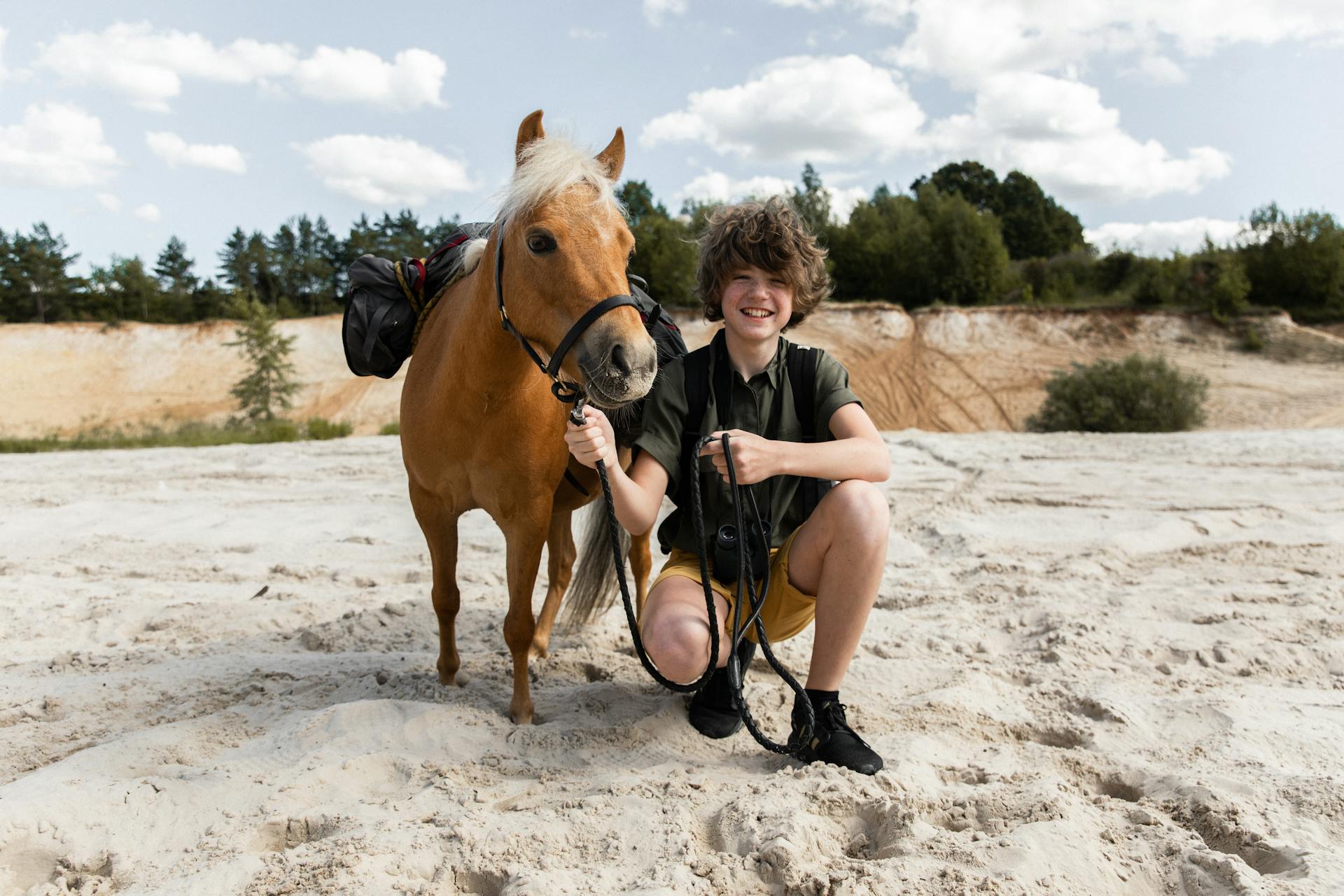
To be a good mobility dog, a canine should have a solid structure, with legs of the same length, and be muscular but not too heavy. They should also have a healthy and balanced appearance.
A good mobility dog should be at least 23-24 inches tall and weigh at least 25 kg / 55 lbs. If the dog is expected to help a large person, its recommended weight is over 45 kg / 100 lbs.
Mobility dogs are required to be loyal, responsive, and calm, with a stable temperament and good personality. They should not be hyperactive, too lazy, or easily distracted.
Here are some key features of a good mobility dog:
- Large size (at least 23-24 inches tall and 25 kg / 55 lbs)
- Solid structure with legs of the same length
- Muscular but not too heavy
- Healthy and balanced appearance
- Stable temperament and good personality
- Loyal, responsive, and calm
What a Service Does
A service dog, like a mobility service dog, is trained to assist individuals with disabilities, helping them with daily tasks and increasing their independence. These dogs are trained to perform a variety of tasks, from opening doors and fetching items to providing physical support and balance.
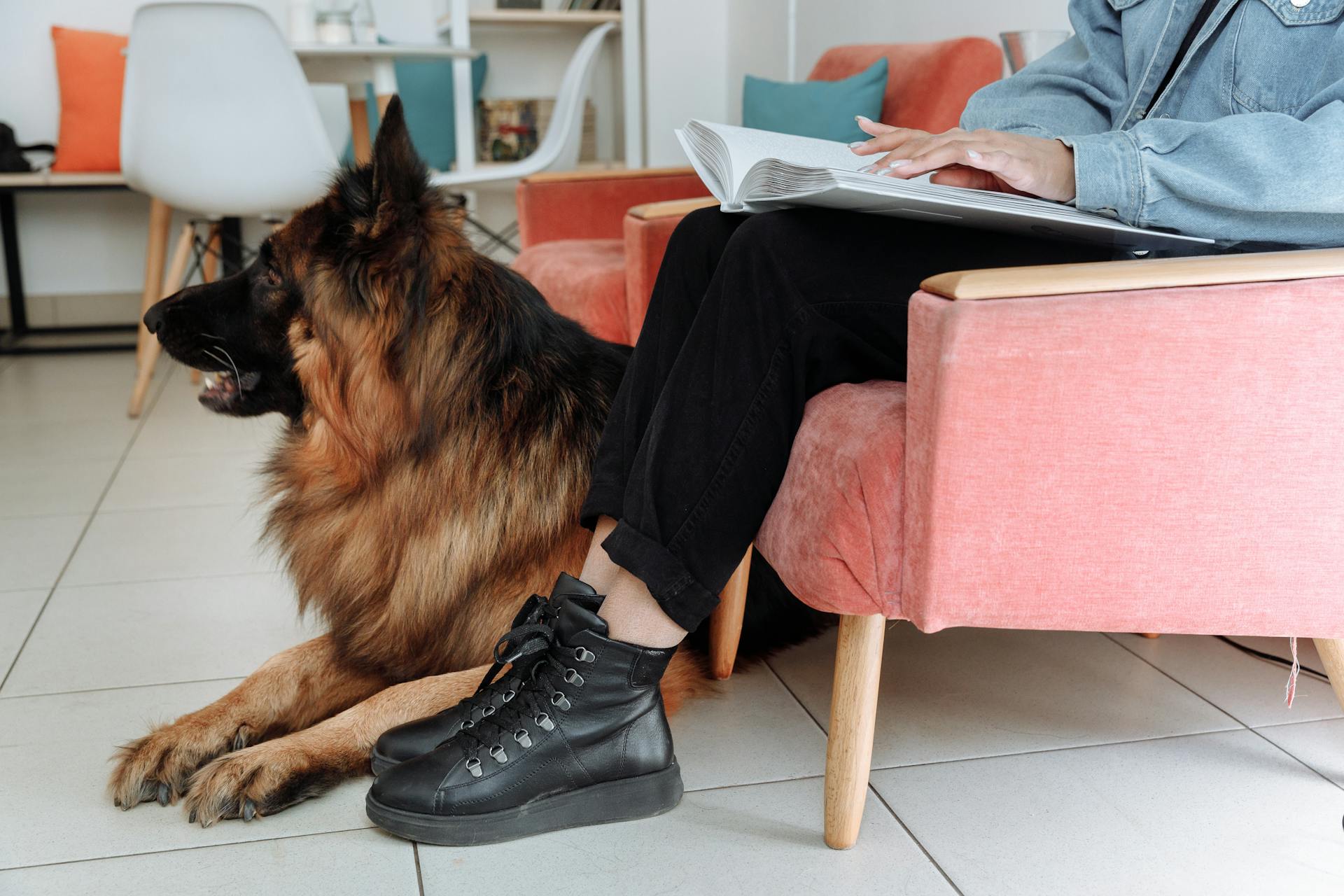
Mobility service dogs, in particular, are trained to help their owners with mobility issues, such as bracing them to prevent falls, pushing buttons and light switches, and fetching items out of reach. They can also serve as a counterbalance, helping their owners walk in a straight line and avoid bumping into things.
These dogs can be trained to perform a range of tasks, including:
- Opening and closing doors and drawers
- Pushing buttons and flipping light switches
- Fetching, carrying, or placing items down
- Assisting a person in a wheelchair
- Providing physical support and balance
- Assisting their owner to stand up or remain upright
- Serving as a counterbalance or assist their owner in walking in a straight line
In emergency situations, mobility service dogs are trained to react quickly, such as barking to notify bystanders or initiating a call to 911. They can also retrieve emergency medication, stand over their owner to prevent injury, and nudge them into a recovery or safety position.
Best Breeds for Service
If you're considering getting a mobility service dog, you'll want to choose a breed that's physically capable of assisting you. A good mobility dog should be at least 23-24 inches tall and weigh at least 55 pounds.
A dog's physical features are crucial for its role as a mobility service dog. They should have a solid structure, be balanced with legs of the same length, and be quite muscular but not too much.

Some of the best breeds for mobility service dogs are Retrievers, such as Golden Retrievers and Labrador Retrievers. These breeds are known for their intelligence, loyalty, and calm temperament.
The size of a mobility service dog depends on the size and needs of the person they're working for. For average adults, a service dog assisting with mobility should be over 60 pounds.
The German Shepherd, Doberman Pinscher, Bernese Mountain Dog, Rottweiler, Standard Poodle, and Newfoundland are also considered excellent breeds for mobility service dogs.
Here's an interesting read: Good Breeds for Psychiatric Service Dogs
How to Choose Treats for Training
Choosing the right treats for your service dog training is crucial. Use high-value treats for teaching crucial skills like medical alerts or guide work.
Treats should be matched to the task at hand. For practice sessions, use medium-value treats.
There is an incredible variety of service dog tasks that help with qualifying disabilities. This means you'll need a variety of treats to keep things interesting and rewarding for your dog.
Basic treats are perfect for everyday good behavior. They're not as exciting as high-value treats, but they're still a great motivator.
Training and Care
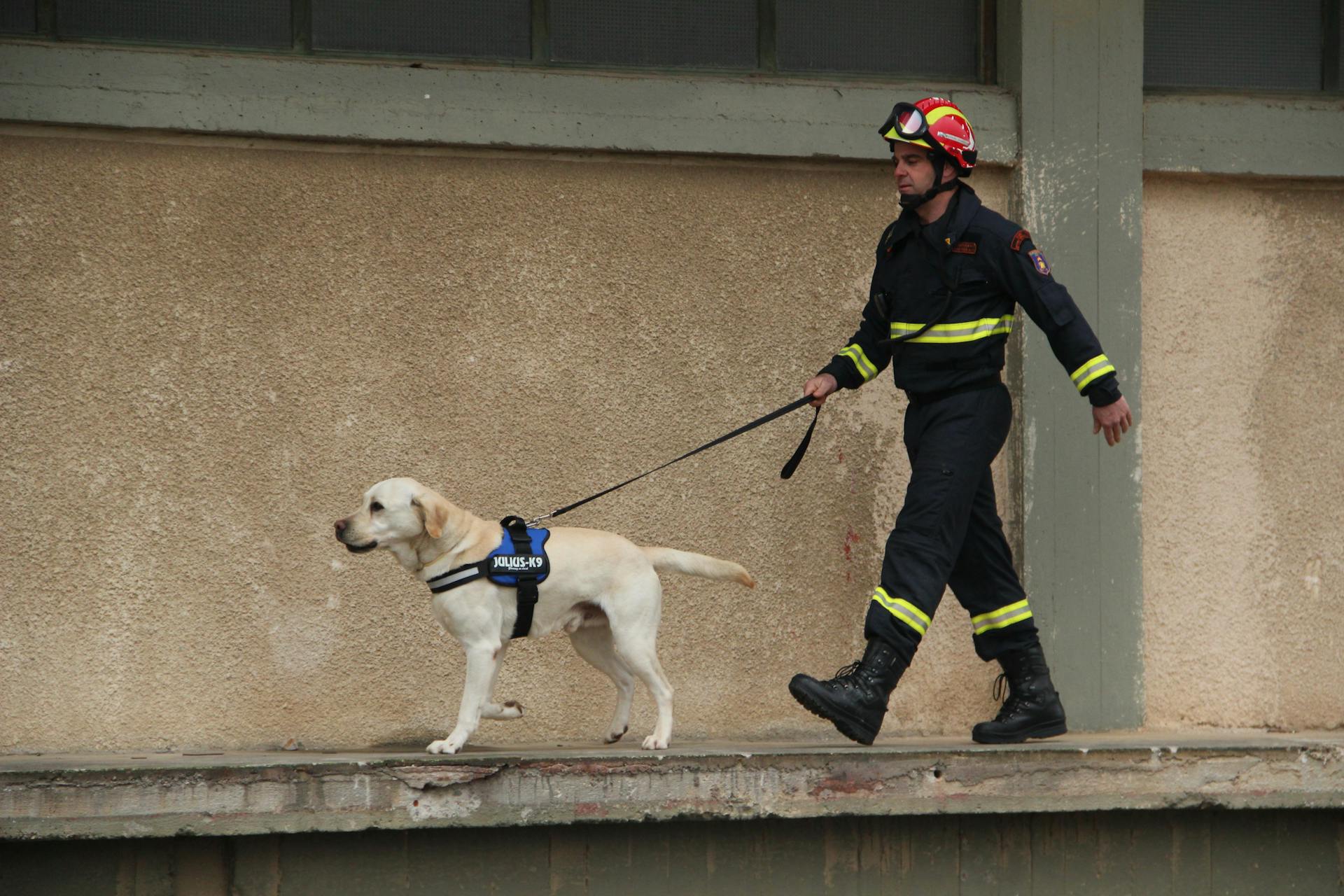
Training a mobility service dog requires a lot of time, energy, and commitment. A dog must be at least 6 months old to be recognized as a service dog, but you can start training at a young age, as early as a few weeks, but not less than 8.
To be a full-capacity mobility dog, a dog should be at least 2 years old. This is because demanding tasks like pulling a wheelchair require a developed bone structure and closed growth plates.
Mobility dogs can be trained to perform a wide range of tasks, including opening doors, turning on lights, and pressing buttons. They can even be trained to bring medication, retrieve fallen objects, and help their handler with impaired mobility go to a safe place.
A good mobility dog should be specially trained to meet certain needs and perform specialized tasks, often without a cue word from their handler. If you're considering training a mobility dog, be sure to research organizations that provide mobility service dogs and evaluate their legitimacy and the skills of their trainers.
Additional reading: What Tasks Do Service Dogs Perform
Training Duration
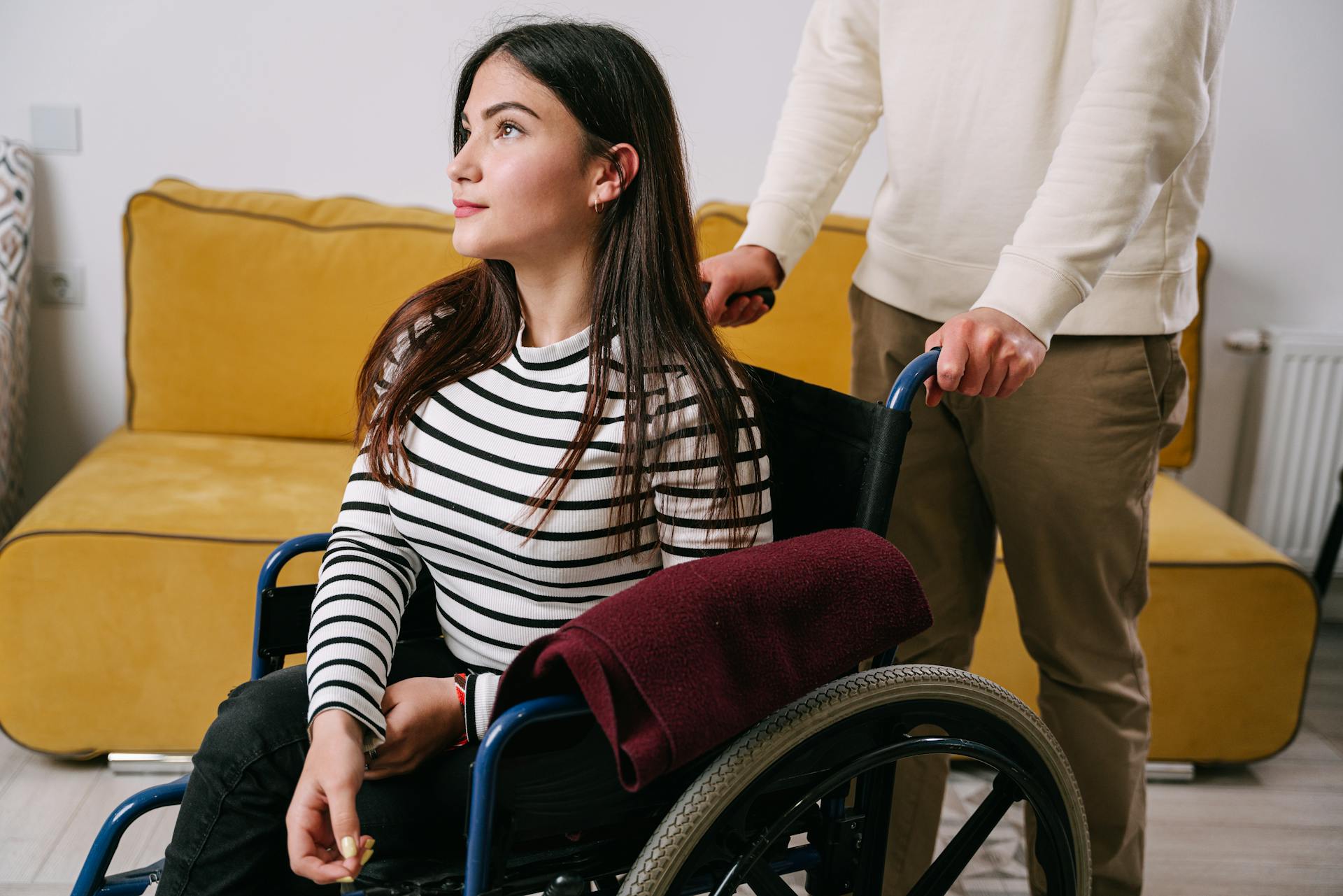
Training a mobility service dog requires a significant amount of time and effort. A minimum of 120 hours of training is necessary, which can take at least six months to complete.
You can start training a mobility dog at a young age, but not less than 8 weeks old. This allows you to lay a solid foundation for their skills and behavior.
Demanding tasks like pulling a wheelchair require a developed bone structure and closed growth plates, which usually happens around 2 years old.
Broaden your view: How Old Do Service Dogs Have to Be
Grocery Store Run
You're planning a grocery store run with your service dog? Service dogs can go into any grocery store with you, even if the store has a no-pets policy.
If you can go somewhere in the store, your service dog can, too. Service dogs can even ride in the shopping cart with you, making it easier to navigate the aisles.
Additional reading: Can Service Dogs Go Anywhere
Service Dog Features
A mobility service dog should be large, at a minimum of 23-24 inches tall, and weigh at least 25 kg / 55 lbs.

To be a good mobility dog, a canine should have a solid structure, with legs of the same length, be quite muscular, but not too much, and have strong bones.
A good mobility dog should be loyal, responsive, and very calm, without feeling anxious or stressed due to the tasks they perform.
Mobility dogs should have a stable temperament and be easy-going, not hyperactive, too lazy, or easily afraid.
They should be trainable and focus exclusively on their handler, resisting any distractions in their surroundings.
A mobility dog should weigh over 45 kg / 100 lbs if expected to help a large man or woman, and be at least 30 inches tall.
Training Process
Training a mobility service dog requires a significant amount of time and effort, with a minimum of 120 hours of training and at least six months of training in total.
The training process involves teaching the dog to perform specialized tasks that go beyond basic obedience and social skills, such as assisting a handler who is experiencing dizziness or is unconscious.
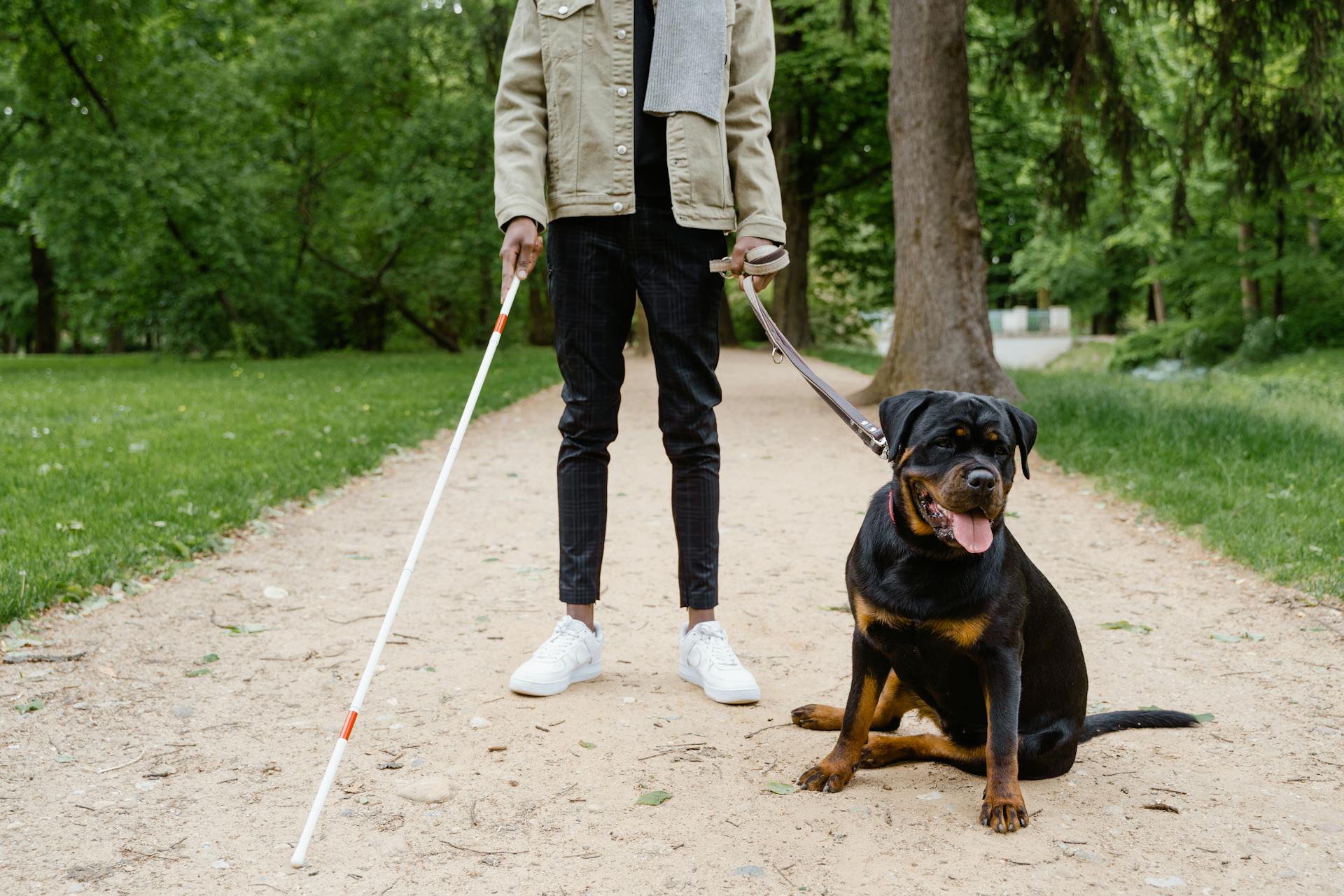
A good mobility dog should be able to perform tasks without a cue word from their handler, and their behavior in public places should be focused solely on the handler's needs.
You need to invest time, energy, and commitment if you decide to train your own service dog, as allowed by the ADA (Americans with Disabilities Act) in the US.
It's essential to evaluate the legitimacy of organizations that provide mobility service dogs and check the skills of their trainers, such as Medical Mutts.
An additional 30 hours of training in a public setting can help a mobility service dog execute their skills in a community environment without being intrusive with others.
Recommended read: Public Access Test for Service Dogs
Special Considerations
When considering a mobility service dog, it's crucial to think about their health condition. Over-bred dogs are likely to suffer from different health issues.
You'll want to ensure your future service dog is in perfect health condition to perform tasks effectively. Any health or genetic illness may affect their ability to do their job.
Requiring a health certificate as proof of your future dog's health condition is a must. This will give you a clear understanding of any potential health issues.
A unique perspective: Mental Health Service Dogs California
Emergency Assistance Tasks
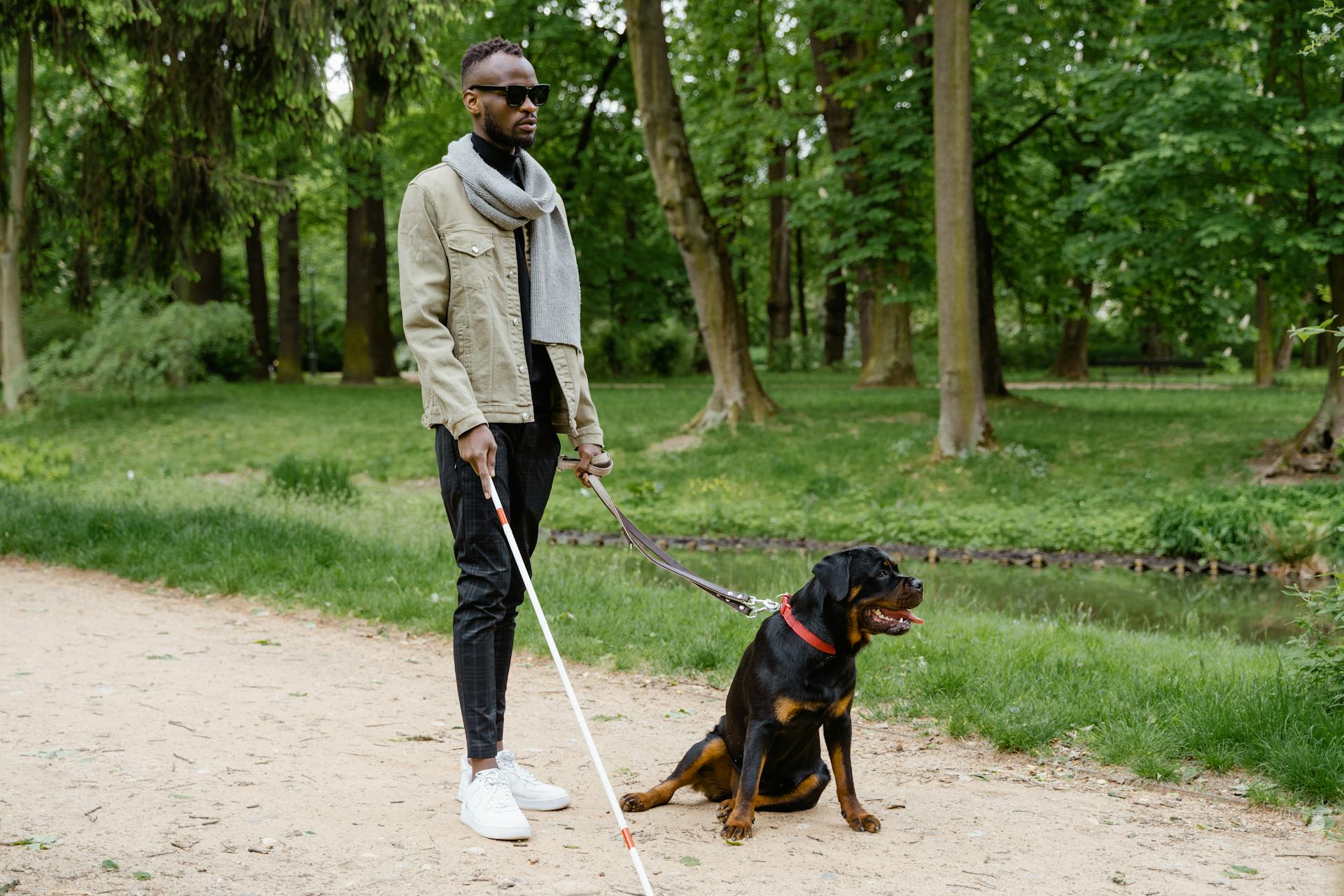
In cases of emergency, mobility service dogs are trained to react in specific ways to help their owners. They can bark to notify bystanders or other people in the home of an emergency.
Their training also includes initiating a call to 911, opening doors, or barking to alert first responders to their owner's location. This can be a lifesaver in emergency situations.
Mobility service dogs are also trained to retrieve emergency medication, which can be a crucial task in certain situations. This shows just how dedicated these dogs are to their owners' well-being.
If their owner falls, a mobility service dog will stand over them to prevent them from being injured or stepped on. This is a vital function that can prevent serious harm.
In some cases, a mobility service dog may be trained to nudge their owner into a recovery or safety position. This can help their owner get back on their feet.
Broaden your view: Financial Help for Service Dogs

Here are some specific emergency tasks that mobility service dogs can perform:
- Bark to notify bystanders or other people in the home of an emergency
- Initiate a call to 911, open doors, or bark to alert first responders
- Retrieve emergency medication
- Stand over their owner to prevent injury or stepping
- Nudge their owner into a recovery or safety position
- Perform tasks such as removing their owner's clothing during temperature spikes or warming them during rapid temperature drops
These tasks demonstrate just how capable and dedicated mobility service dogs can be in emergency situations.
Health Condition
When selecting a service dog, it's crucial to ensure they're in perfect health condition. Over-bred dogs are likely to suffer from different health issues.
Mobility dogs require physical characteristics to fulfill their tasks successfully.
A health certificate is recommended as proof of the health condition of your future furry friend.
Any health or genetic illness may affect the ability of the dog to perform the needed tasks effectively.
Frequently Asked Questions
What is a mobility service dog?
A mobility service dog is a specially trained dog that assists individuals with physical limitations by performing tasks such as retrieving items, opening doors, and pulling a wheelchair. This type of service dog helps improve independence for those who need it.
What breed is best for mobility service dogs?
Labrador Retrievers, Newfoundlands, and Bernese Mountain Dogs are popular breeds for mobility service dogs due to their gentle nature and physical capabilities. Consider factors like size and temperament when choosing the best breed for your needs.
How big does a dog have to be to do mobility work?
For mobility work, a service dog typically needs to be at least 60 pounds, but size depends on the individual's needs and size. A smaller dog may be sufficient for retrieval tasks, but larger dogs are often required for falls assistance and other mobility needs.
Can a service dog help with balance?
Service dogs can provide balance assistance through stability training, helping handlers stay upright and steady. This can be especially helpful for individuals with mobility or balance impairments
Sources
- https://www.akc.org/expert-advice/news/mobility-service-dogs/
- https://littleangelsservicedogs.org/disabilities-served/mobility-assistance/
- https://eenp.org/programs/mobility
- https://www.servicedogcertifications.org/mobility-service-dogs-guide/
- https://www.servicedogtrainingschool.org/blog/mobility-service-dogs
Featured Images: pexels.com


